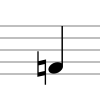Music in English
Let’s practise a bit the musical symbols in English:
|
English note names: |
|
However, Germany uses the same letters and an H, the H is used for SI and B is used for SI flat (SI bemoll) |
Staff = Pentagrama Staff is the fundamental latticework of music notation, upon which the symbols are placed. It contains 5 lines and 4 intervening spaces. |
Bar line or Barline = Barra Bar line or Barlin: A vertical line on the staff to separate measures in a composition. |
Double bar line or double barline = doble barra Double bar line or doblue barline: Used to extend the staff to pitches that fall above or below it. Such ledger lines are placed behind the note heads, and extend a small distance to each side. Multiple ledger lines can be used when necessary to notate pitches even farther above or below the staff. |
Bold double bar line or Bold double barline = Doble barra final Bold double bar line or Bold double barline: Used to separate two sections of music or placed before a change in key signature. |
Ledger or ledger lines = Línies adicionals  Ledger or ledger lines: Used to extend the staff to pitches that fall above or below it. Such ledger lines are placed behind the note heads, and extend a small distance to each side. Multiple ledger lines can be used when necessary to notate pitches even farther above or below the staff. |
G clef or Treble clef = Clau de Sol |
F clef or Bass clef = Clau de Fa |
C clef = Clau de Do |
Measure = Compàs (entre dos barres) Measure: The space between one bar and the next Measure: The space between one bar and the next |
Time signature = Compàs (indicació de compàs) |
Semibreve (US) / Whole note (UK) = Rodona |
Minim (US) / Half note (UK) = Blanca |
Crotchet (US) / Quarter note (UK) = Negra |
Quaver (US) / Eighth note (UK) = Corxera |
Semiquaver (US) / Sixteenth note (UK) = Semicorxera |
Demisemiquaver (US) / Thirty-second note (UK) = Fusa |
Hemidemisemiquaver (US) / Sixty-fourth note (UK) = Semifusa |
Dotted note = Puntet |
Triplet = Treset |
Tie = Lligadura Tie: Indicates that the two (or more) notes joined together are to be played as one note with the time values added together. To be a tie, the notes must be identical; that is, they must be on the same line or the same space; otherwise, it is a slur (see below). |
Rest = Silenci Rest: A symbol used to indicate silence in music. Rest: A symbol used to indicate silence in music. |
| Rhythym = Ritme |
| Beat = PulsacióBeat: A musical pulse or unit of time / the steady pulse of music. |
Flat = Bemoll Flat: a symbol written to the left of a note that lowers the pitch by a half step. |
Sharp = Sostingut o diesi Sharp: a symbol written to the left of a note that raises the pitch by a half step. |
Natural = Natural o becaire Cancels a previous accidental, or modifies the pitch of a sharp or flat as defined by the prevailing key signature. |
Key signature = Armadura  Flat key signature Lowers by a semitone the pitch of notes on the corresponding line or space, and all octaves thereof, thus defining the prevailing major or minor key. Sharp key signature Raises by a semitone the pitch of notes on the corresponding line or space, and all octaves thereof, thus defining the prevailing major or minor key. |
Fermata: Calderó A note, chord, or rest sustained longer than its customary value. Usually appears over all parts at |
Chord: Acord Several notes sounded simultaneously (“solid” or “block”), or in succession (“broken”). Two-note chords are called dyad; three-note chords are called triads. A chord may contain any number of notes. |
Musical instruments in English:
Conductor: director d’orquestra
String instruments: Instruments de corda
Violin: Violí
Viola: Viola
Cello: Violoncel
Contrabass: Contrabaix
Harp: Arpa
Woodwind instruments: Instruments de vent-fusta
Piccolo: Flautí
Flute: Flauta travessera
Oboe: Oboè
English horn: Corn anglès
Clarinet: Clarinet
Bass clarinet: Clarinet baix
Basson: Fagot
Contrabasson: Contrafagot
Brass instruments: Instrments de vent-metall
Horm: Trompa
Trumpet: Trompeta
Valve trombone: Trombó de pistons
Trombone: Trombó de vares
Tuba: Tuba
Saxophone: Saxòfon
Percussion instruments: Instruments de percusió
Timpani or Kettledrum: Timbales
Tom-Toms / Mounted toms / Right and Left Tom / Middle and High Tom: Timbales (de bateria)
Bass drum: Bombo
Snare drum: Caixa
Ride cymbal: Plat
Triangle: Triangle
Xylophone: Xilòfon
Vibraphone: vibràfon
Tubular bells: Campanes tubulars
Bongos: Bongos
Maracas: Maraques
Hit hat: Xarles
Gong: Gong
Marimba: Marimba
Cuica: Cuica
Mirliton or Kazoo: Nunut o Mirlitó
Recorder: Flauta de bec o flauta dolça
kalimba: Kalimba
Drums: Bateria
Floor tom-tom: Goliat
Hit-hat: Xarles
China blocks: Blocs xinesos
Hanging toms: timbales de bateria
Castanets: Castanyoles
Jew’s harp: Guimbarda
Glass harmonica, glass armonica, bowl organ, hydrocrystalophone, or armonica: Harmònica de cristall
Glass arp, musical glasses or singing glasses: copes afinades
Tambourine: Pandereta
Djembe: Djembé
Darbukka: Darbukka
Bendir: Bendir

